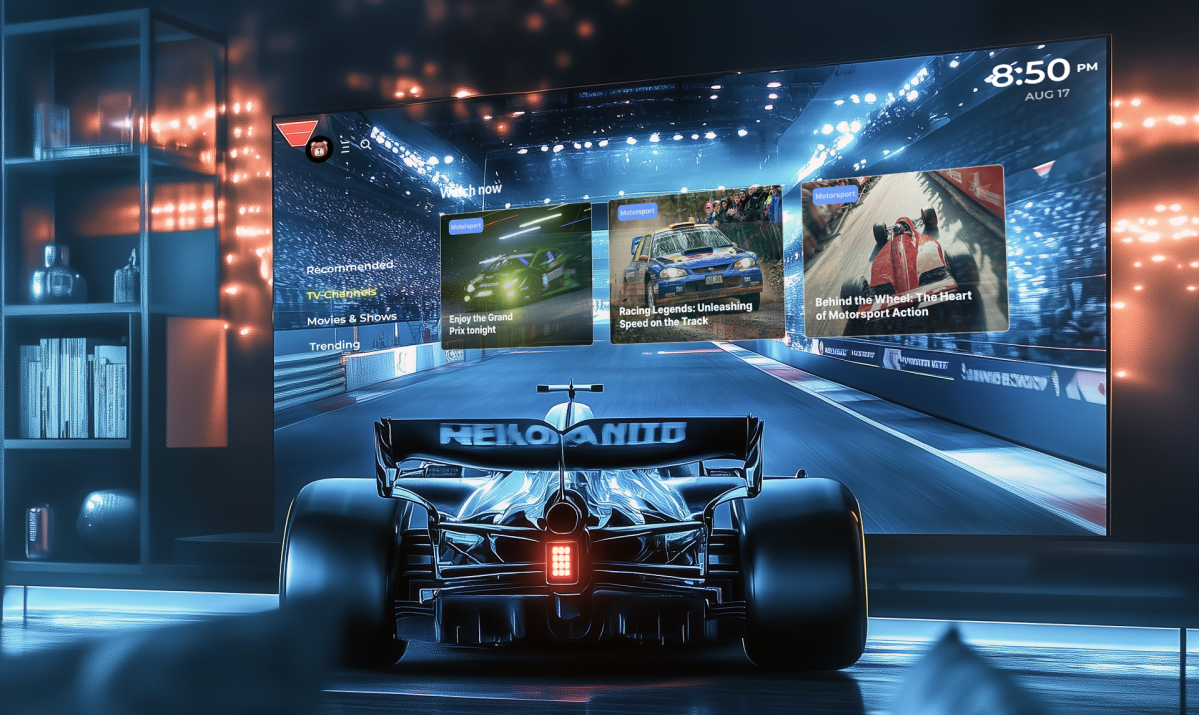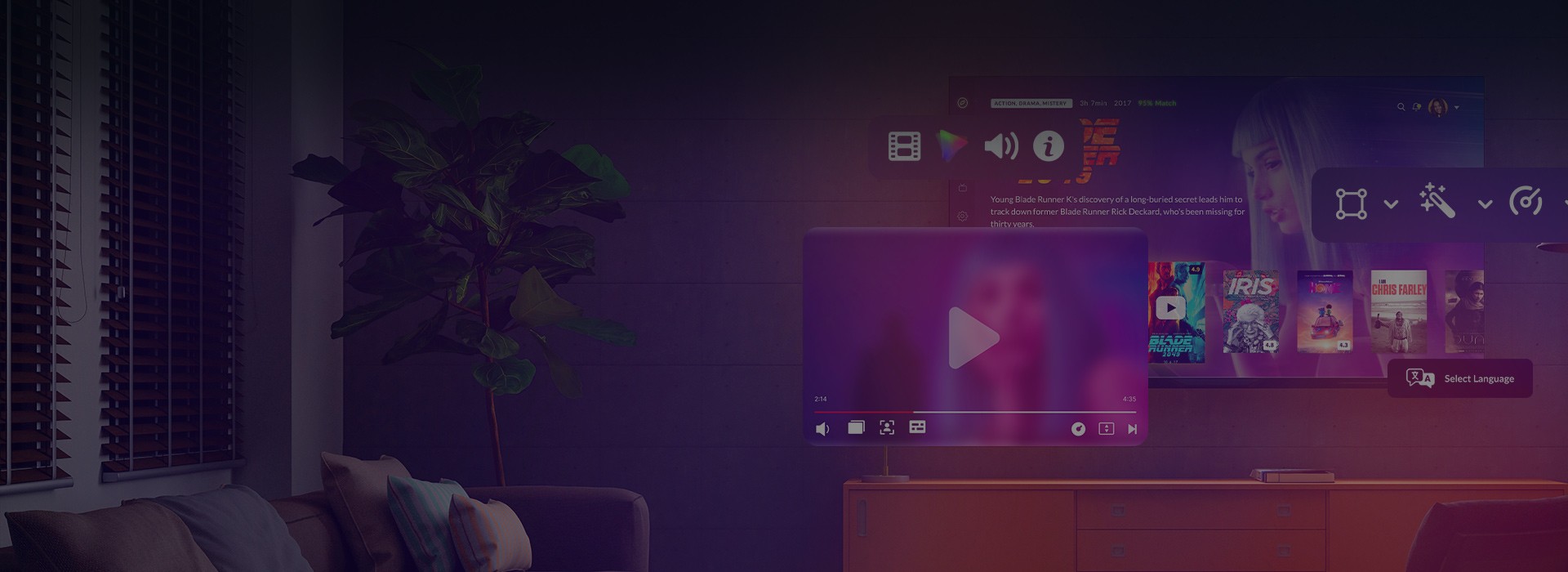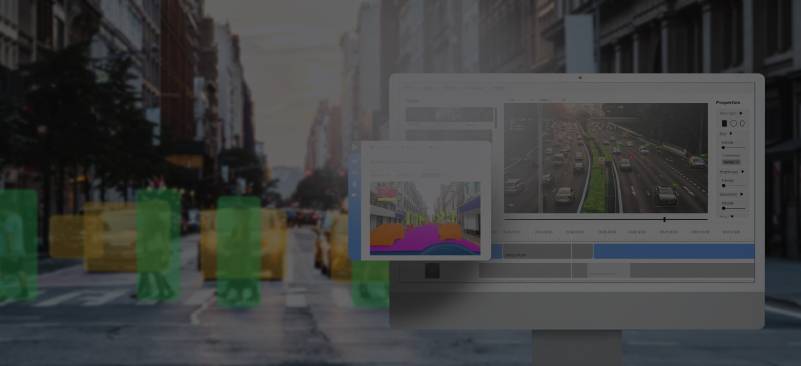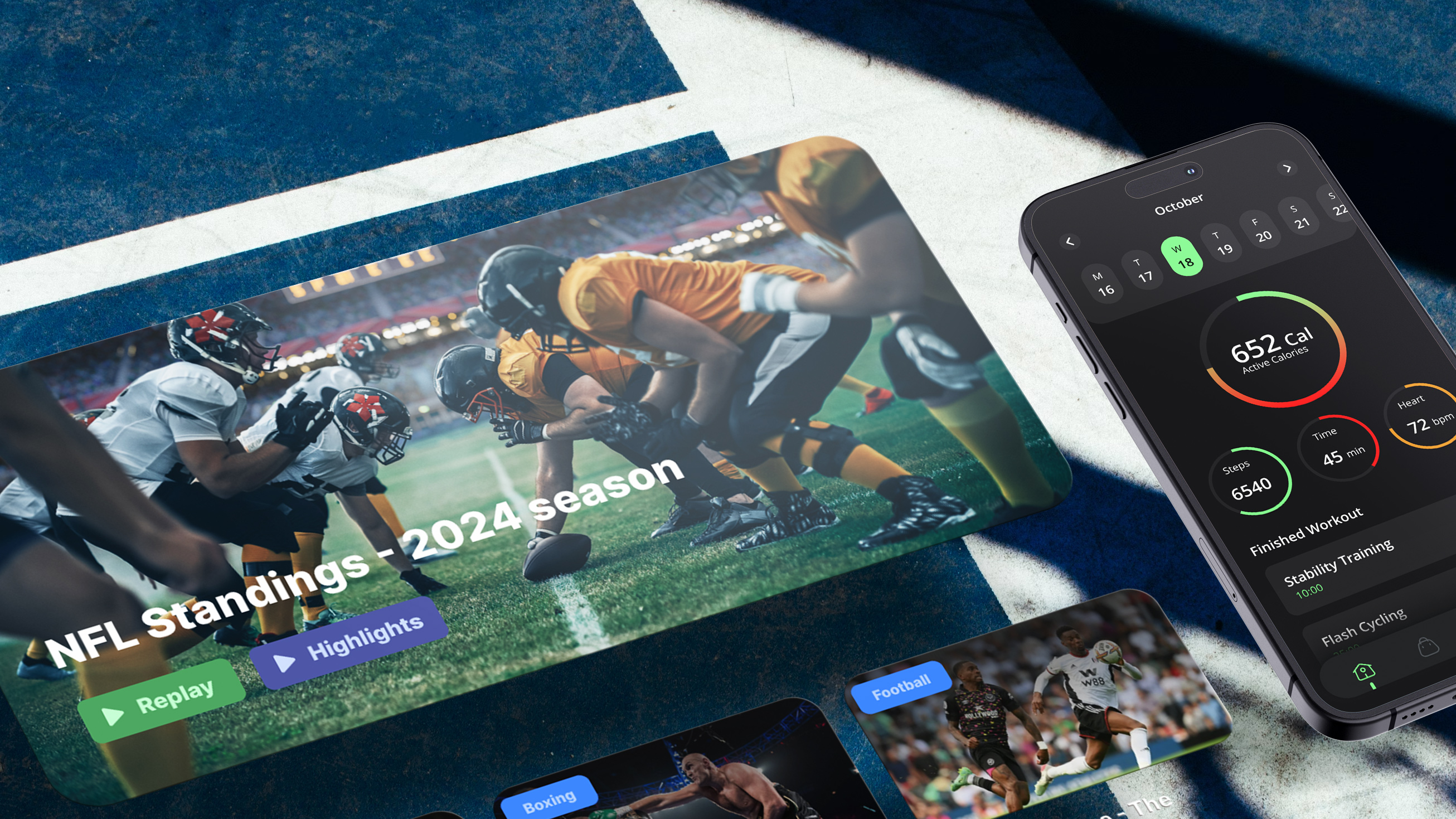Imagine this: A single platform where users stream live sports with real-time stats, binge their favorite shows across devices, and catch up on missed episodes without ever thinking about a schedule — all while your team unlocks revenue through ads, subscriptions, and pay-per-view events.
That’s not just possible — it’s happening. And IPTV is the engine behind it.
2025’s streaming market is crowded and the platforms winning market shares aren’t just the ones with great content — they’re the ones with smart delivery, monetization flexibility, and a seamless multi-screen experience. IPTV (Internet Protocol Television) gives you all of that and more.
Whether you’re considering launching live streams, expanding your VoD offering, or adding catch-up features to keep users engaged longer, IPTV opens the door to new business opportunities.
In this article, we’ll break down:
- What IPTV actually is (and how it differs from OTT),
- The three main types of IPTV services — live TV, VoD, and time-shifted TV,
- And how each type enables unique monetization strategies to boost your platform revenue.
Let’s explore how IPTV can help future-proof your platform — and turn every stream into a new opportunity.
What is IPTV (and why it’s a game-changer right now)?
Let’s be real — audiences today may not care how content gets to their screens. They just want it now, in HD, on whatever device they’re using… with the ability to pause, rewind, or binge it later. That’s where IPTV steps in.
IPTV (Internet Protocol Television) is TV, but smarter. It delivers content over internet networks — not outdated cables or satellites. Think live sports, on-demand series, and time-shifted TV, all streaming smoothly without the quirks of traditional broadcasting. Unlike OTT services like Netflix, which rely on the open internet, IPTV can run on managed networks — meaning more control, better quality, and fewer headaches when millions log in at once.
For content platforms, IPTV isn’t just an upgrade — it’s a whole new way to engage and monetize. It lets you stream live events, offer a deep VoD library, and add catch-up features that today’s users expect as a baseline. Want to go multi-device? Personalize streams? Insert ads dynamically? IPTV makes all of that possible.
Whether you’re building the next breakout streaming platform or evolving a legacy Pay TV service, IPTV gives you the tools to compete — and the flexibility to grow. It’s not just about keeping up anymore. It’s about leading. So what are the types of IPTV — and how can you ride the wave instead of getting swept away?
Live streaming IPTV: Real-time, real revenue
When you would like to get content streams now, Live IPTV is the answer. It delivers the thrill of real-time TV — breaking news, concerts, live sports — straight to users across devices, with zero need for cable, and zero patience for lag.
Once the domain of telecom bundles, live IPTV may be a go-to strategy for content platforms of all sizes. Why? Because live content sparks urgency, drives spikes in viewership, and keeps audiences glued in the moment — the perfect storm for monetization.
From one-time events to 24/7 channels, live streaming is no longer optional. It’s what turns passive platforms into must-watch destinations.
How it works
Live IPTV starts with capturing a broadcast or on-site camera feed, then encoding and delivering it via CDNs using protocols like HLS or DASH. Adaptive bitrate streaming ensures smooth performance, even on shaky networks. Behind the scenes, cloud auto-scaling and multi-CDN architecture are critical for handling massive surges in traffic, especially during peak live events.
DRM, tokenized URLs, and geo-blocking protect your premium streams from piracy and unauthorized access.
These moving parts need to work seamlessly — and that’s exactly the kind of infrastructure Oxagile delivers through its custom video solutions, tailored to support real-time video delivery, monetization, and cross-device experiences at scale.
Why it matters
Live streaming isn’t just about immediacy — it’s about impact. Platforms that feature live content (especially sports or news) enjoy higher session times, stronger brand loyalty, and more monetization potential.
Let’s take live sports streaming — one of IPTV’s most high-stakes use cases. To deliver that experience at scale, platforms need:
- Ultra-low latency (no one wants to hear the goal on Twitter before seeing it),
- Scalable infrastructure to support peak loads,
- Adaptive bitrate delivery for quality across devices, and
- Strong DRM and geo-blocking to comply with broadcast rights.
Oxagile’s live streaming expertise, including sports streaming, brings all this to the table — along with support for interactive overlays, second-screen syncing, and live betting integrations.
Monetization options
- Subscriptions: Bundle premium live events or 24/7 channels into SVOD tiers.
- Pay-per-view: Sell access to high-value, one-off events.
- Advertising: Inject targeted ads mid-stream using SSAI or dynamic ad platforms.
- Interactivity: Drive engagement and revenue with features like real-time polls, clickable overlays, trivia, or shoppable links.

From passive watching to active engagement
Want to turn viewers into active participants? Oxagile’s interactive video streaming solutions support real-time chatting, live leaderboards, gamified events, and audience-triggered actions — creating richer experiences that boost both engagement and revenue.
Oxagile in action: From zero to racetrack hero
Here’s what happens when IPTV is done right — fast.
A major motorsport media group came to Oxagile with a high-octane challenge: build a live and on-demand platform for racing fans around the world that could handle massive traffic, deliver flawless playback, and monetize the adrenaline.
We rolled up our sleeves and engineered a powerhouse solution using the Wowza streaming engine and multi-CDN architecture — no buffering, no delays, just smooth, real-time action across web, mobile, and set-top boxes. Adaptive bitrate streaming kept every viewer in the zone, no matter the device.
But this wasn’t just about streaming fast cars — it was about building a business engine. The platform ran on a subscription video-on-demand model (SVOD) for hardcore fans, added ad-supported content for wider reach, and even offered white-label licensing to regional distributors.
And the fan experience? Next level. Live commentary, interactive chats, instant replays — everything to keep viewers glued to the screen and coming back for more. Casual viewers may quickly become monthly subscribers.

The result? More sign-ups, more engagement, more revenue. This is what happens when killer content meets the right tech stack – and Oxagile’s team knows how to drive it all the way to the finish line.
Video on Demand (VoD) IPTV
If live IPTV is about capturing the moment, VoD IPTV is about owning every moment after. It’s the cornerstone of modern streaming — the “watch anytime, anywhere” model that today’s audiences expect by default.
VoD lets users dive into massive content libraries — from blockbuster movies and trending shows to niche content and user-generated gems. Whether they’re binge-watching a series or catching a missed episode, they’re in control.
Originally bundled into IPTV packages by telcos, VoD has evolved into a core offering for any serious content platform — not just for user satisfaction, but as a flexible, monetization powerhouse.
How it works
VoD content is uploaded, encoded, and stored in the cloud, organized through a content management system, and streamed via CDN on demand. Adaptive bitrate streaming ensures smooth playback, while DRM secures premium titles. Media asset management keeps libraries searchable and scalable. Popular features include offline viewing, watchlists, resume playback, and increasingly, hyper-personalized recommendations.
Personalization that converts
Oxagile builds VoD platforms with AI-powered personalization engines, enabling viewer-specific carousels, segmented content suggestions, and tailored upsell prompts — helping turn casual watchers into loyal subscribers.
Why it matters
Unlike live streams, VoD titles have a long-term shelf life — viewable again and again by new users over time. That’s endless engagement potential. VoD supports binge behavior, ad inventory growth, and smart segmentation — all of which lead to better retention and revenue.
But expectations are sky-high. You’re competing with the biggest names in streaming, so your VoD offering needs to deliver:
- Smooth UX across platforms
- Consistent cross-device playback
- Smart search and discovery
- Support for 4K, HDR, and other modern viewing standards
That’s where Oxagile’s multi-platform front-end expertise (web, Smart TVs, STBs, Roku, Apple TV, Android TV, and more) comes in.
Monetization models for VoD
VoD’s real power? It’s a monetization playground. Whether you’re serving binge-watchers, casual browsers, or niche superfans, there’s a revenue model — or a mix — that fits your content, audience, and goals.
As Oxagile’s experts put it in their deep dive on OTT business models:
“Video content monetization commenced long ago, even before the era of DVD rentals, where viewers paid for temporary access to physical media, a precursor to modern OTT platform monetization. However, the advent of OTT platforms revolutionized the paradigm, introducing a new period of on-demand content delivery.”
Here are four proven VoD monetization models — and yes, the smartest platforms often blend them:
- SVOD (Subscription video on demand): Users pay a recurring monthly or annual fee for unlimited access to your library. It’s predictable, great for building long-term value, and works best when you’ve got strong content or a focused niche audience.
- AVOD (Ad-supported video on demand): Content is free, and revenue comes from advertising. It’s ideal for broader audiences and smaller libraries, especially with smart AdTech in place — like dynamic ad insertion, targeting, and performance tracking.
- TVOD (Transactional video on demand): Pay-per-view or rentals for premium or exclusive content. It’s hit-driven but high-yield, making it perfect for new releases or live event replays.
- Hybrid: Combine models to unlock full revenue potential. Offer a free AVOD tier to attract users, then upsell SVOD for premium or ad-free experiences. Or mix SVOD and TVOD — Netflix’s own ad-supported tier is proof that even giants are leaning into hybrid strategies.
The key? Start with your audience and content, then build the revenue engine around them. What works now might evolve in six months — and IPTV gives you the flexibility to adapt without breaking your platform.

Real-world example: Turning VoD into a revenue engine
When a telecom broadcaster needed to overhaul their VoD experience, they teamed up with Oxagile to make it happen — and turned a basic content library into a powerful monetization machine.
We rebuilt the platform with AI-driven recommendations, a slick, responsive multi-device UX, and a custom ad module that supported both AVOD and hybrid models. The result? Smarter content discovery, more relevant ads, and a seamless experience across screens.
With advanced targeting and personalized viewing paths, Vodafone didn’t just serve content — they maximized the value of every user interaction. The platform’s reach grew. So did the revenue.
Lesson learned? Great content is only half the equation. With the right tech, it becomes a business engine.
Time-shifted IPTV: Because viewers hate missing out
In a world where attention is divided and schedules are unpredictable, Time-Shifted IPTV is your secret weapon. It bridges the gap between live TV and VoD by giving users one simple superpower: the freedom to watch what they missed — on their terms.
Whether it’s a news broadcast they couldn’t catch live or a series episode that aired while they were stuck in traffic, time-shifted viewing (via catch-up TV, start-over, or cloud DVR) puts them back in control — without leaving your platform.
For content providers, it’s more than just a nice-to-have — it’s a retention booster, monetization extender, and competitive edge all rolled into one.
Personalization that converts
In fact, many traditional broadcasters are now racing to adopt features like catch-up and DVR as part of their digital reinvention strategies. As highlighted in this article on how traditional TV is reinventing itself, viewer expectations have shifted — and time-shifted IPTV is becoming a baseline, not a bonus.
Common features
- Catch-up TV: Automatically records select channel broadcasts and makes them available for a set period (e.g., 7–30 days) with no setup required.
- Start-over TV: Lets users rewind to the beginning of a currently airing program.
- Cloud DVR: Allows users to record live programs and access them anytime via personal cloud storage.
These features provide flexibility and control, reducing the risk of users leaving your platform due to missed content.
How it works?
Time-shift functionality relies on recording and temporarily storing live streams. Systems either buffer channel streams automatically or allow users to save specific programs to the cloud DVR (Digital Video Recorder). Efficient storage, fast retrieval, and seamless playback are essential. User-friendly interfaces — like clickable EPGs with past programs — are also key to adoption.
Platform benefits
- Retention booster: Viewers who miss live content stick around longer when they know they can catch up.
- Maximized content value: A single broadcast can generate views and ad impressions over multiple days.
- Competitive edge: Offering catch-up or DVR features can differentiate your service, especially if rivals don’t have licensing rights.
- Tiered monetization: DVR access can be packaged into higher-tier plans to raise the average revenue per user.
- Advertising potential: Time-shifted streams support dynamic ad insertion, allowing fresh or targeted ads to be shown long after the live event.
- Data insights: Time-shifted behavior reveals valuable patterns — like which shows have staying power — helping guide licensing and marketing.
Monetization strategies
- Subscription incentives: Promote time-shift as a premium feature (e.g., “7-Day Catch-Up Included”).
- DVR upsells: Offer tiered storage or DVR access in higher-priced plans.
- Ad revenue: Insert unskippable or dynamic ads in replayed content to increase inventory and relevance.
- Enterprise monetization: For hotels or telecoms, offer DVR as a value-added feature for higher per-user pricing.

Time-shifted IPTV doesn’t just enhance viewer convenience — it amplifies the lifespan and monetization of your content. With Oxagile’s expertise in custom IPTV solutions, including DVR and catch-up capabilities, we help platforms turn every missed show into another engagement and monetization opportunity.
Choosing the right IPTV mix for your platform
Here’s the truth: IPTV isn’t a one-size-fits-all solution — it’s a toolkit, and how you mix and match its parts determines how far your platform can go.
Live IPTV brings the real-time thrill — perfect for sports, events, and anything that thrives on urgency. VoD delivers depth and longevity, keeping users engaged with a binge-worthy catalog and flexible monetization models. Time-shifted IPTV? That’s your convenience kicker — the feature that makes sure no one ever misses out, and your content keeps paying off long after airtime.
So, what’s the right combo? That depends on your platform’s DNA:
- Got a sports or event-driven audience? Lead with live IPTV — but don’t skip VoD for highlights and recaps, or catch-up features that keep fans coming back all week.
- Running a general entertainment platform? VoD should be your foundation. Layer on live channels for news or tentpole events, and offer time-shift to stay competitive.
- New to the game? Start lean with VoD (it’s easier to license and scale), then build up to live content. If you’re a traditional broadcaster going OTT, flip that script — start with live and catch-up, then expand into VoD.
And don’t be afraid to test and evolve. Your monetization strategy doesn’t have to be static. Start with SVOD, try AVOD for broader reach, throw in TVOD for premium releases — IPTV lets you do it all under one roof.
What’s non-negotiable? User experience. Today’s viewer expects a seamless jump from Smart TV to tablet to phone without friction or feature loss. That means polished, responsive apps on every screen — Tizen, webOS, Apple TV, Roku, Android TV, mobile, browser, you name it. Each platform has its quirks, so you’ll need expert hands to get it right. But when do you? That’s when users stop bouncing… and start sticking.
Let’s be blunt — the streaming game is crowded, and standing out takes more than good content. You need the tech, the strategy, and the user experience that moves the needle. That’s what IPTV offers.
It’s your chance to combine live thrills, on-demand convenience, and personalized journeys — and monetize every moment along the way. Whether your audience wants to tune in, catch up, or binge all night, IPTV gives you the power to deliver.
Ready to scale smarter with IPTV?
With Oxagile as your development partner, you don’t just get features — you get a future-proof platform built on 20 years of hands-on video tech experience. From live streaming and VoD to advanced personalization and monetization, we deliver custom IPTV solutions that perform, scale, and grow with your business.
Whether you’re looking to launch from scratch or supercharge your existing platform, we’ll help you turn every stream into revenue — and every user into a loyal fan.




























